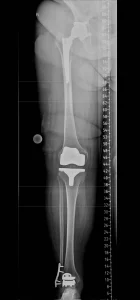Figure 1: Stabilization of the spine, bilateral stabilization of the pelvis and artificial hip joint on the left.
In many patients, we encounter problems that arise from different areas at the same time. The most common are pain in the lumbar spine, buttocks and hip, and pain in the hip, knee and ankle.
Especially the former combination of problems can be difficult for the physician. This is called hip-spine syndrome. Doctors often tend to replace the hip with an arthroplasty first. This is mainly due to the fact that it is one of the most widely used surgical procedures, while only a narrow circle of orthopedic surgeons can operate on the spine. However, such a procedure may not always be correct, and the patient’s problems originating in the spine may worsen after hip arthroplasty. Conversely, a spine surgeon often tends to operate on the spine first, even though most of the patient’s pain originates in the hip joint. In addition, there is pain from the so-called SI joint. This diagnosis is not so easy to make, as well as to perform the surgical treatment of the SI joint.
In the second combination of disabilities, i.e. simultaneous osteoarthritis of the hip, knee and possibly also ankle, the rule is usually to proceed from top to bottom. We usually operate on the hip endoprosthesis first, then the knee endoprosthesis and finally the ankle endoprosthesis. However, even this approach may not be correct in all cases, so we approach each patient individually, according to their problem.
Figure 2: Three artificial joints on one limb: hip, knee and ankle joint endoprosthesis.
